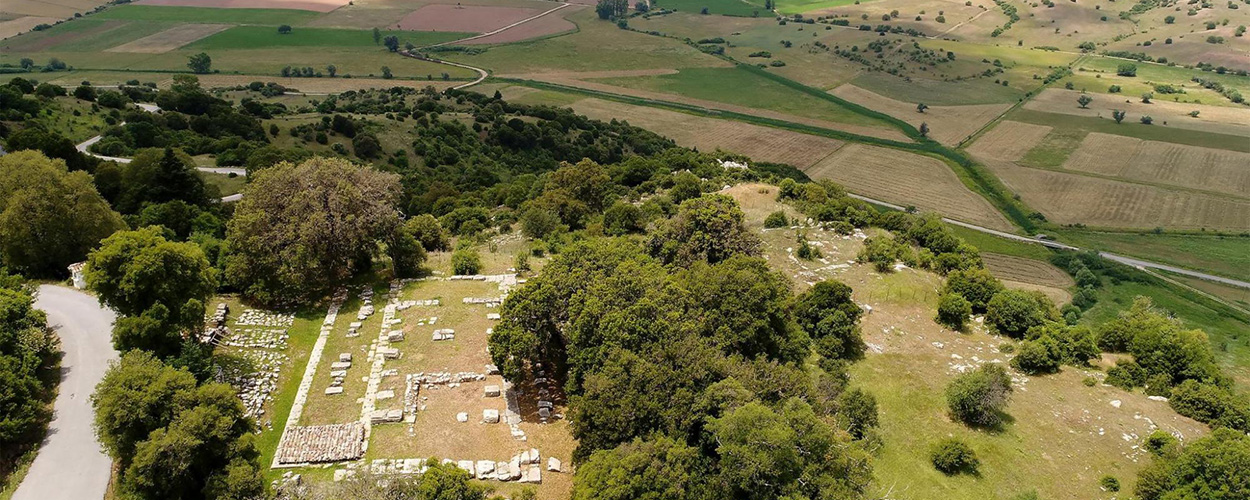Lousoi
The archaeological investigation of ancient Lousoi, beginning in 1898/1899 and continuing without interruption since 1981, represents a traditional focal point in the research programme of the Athens branch of the OeAI. Regarding its diachronic development and supra-regional classification, Lousoi is currently possibly the best-studied settlement site in north-western ancient Arcadia.

The city lies in the region of the ancient Arcadian tribe of the Azanians, in a cultural zone connected to the territories of Achaia and Corinth in the northern Peloponnese. The area of the ancient city, which was systematically researched between 2015 and 2022, extends over the first terraces which rise at the eastern edge of the upland plain of Soudena, surrounded on all sides by mountain chains, to a height of almost 1,000 m above sea level. Since this upland plain, as sediment-filled karstic polje, is only drained underground by means of sinkholes, hydrologic mastery of the region was absolutely vital.
A significant factor in the development of the settlement site was the venerable peri-urban sanctuary of Artemis Hemera. The sanctuary was identified in 1895 on an exposed terrace above a prominent rock outcrop. The preserved votive deposits provide evidence that the cult site was continuously frequented at least from the 9th century BC up until the 1st century AD. Recent research into cult activities in the Geometric and Archaic periods confirms that the sanctuary was of supra-regional importance at an early stage. Its greatest heyday occurred in the Hellenistic period, as indicated by the construction of a hybrid Doric temple, partially in marble, and numerous surrounding buildings in the sanctuary. Competitions in honour of Artemis bestowed an even trans-Mediterranean charisma on the sanctuary.
The history of a meeting place for communal sacrifices and meals can equally be traced back to the Geometric period; this site developed approximately 1 km to the south-west of the Sanctuary of Artemis in flatter terrain. The construction at the same location of two early Archaic apsidal buildings following after each other, a late Archaic cult building only partially known, and an archaising peripteral temple of the Hellenistic era attest to the continuity of this religious site over many centuries. The agora of the polis grew up the immediate vicinity of this area. In similar fashion to other cult sites of the Greek world, the history of building and usage of this area illustrates the central importance of communal sacred meetings for the formation of Greek polis culture. The close functional and spatial interconnection of cult and politics is particularly well-expressed in the archaeological finding of a find complex of four bronze proxeny inscriptions dating to the 5th century BC found in the southern pteron of the Hellenistic temple.
Lousoi's remarkable upsurge into a prosperous small city in the course of the 3rd and 2nd centuries BC is exemplified by the public profane buildings known so far and by private residences, in addition to the extensive building programmes at the traditional cult sites and meeting areas. After the first half of the 2nd century BC, a two-aisled stoa with head structures on both sides served as the western boundary of the agora and probably as the location of political meetings. Two well-furnished residential buildings on the small-scale terraces in the rising terrain in the northern area of the city illustrate in an exemplary fashion that domestic culture here completely conformed to contemporary Hellenistic standards.
In spite of the transfer of power from Lousoi to neighbouring Kleitor at the beginning of the Roman imperial period, finds and evidence attest to a continuous usage of parts of the city area until the 3rd century AD. Two graves from the 5th and 6th century AD, with representative grave goods, allow the supposition that the larger-scale settlement dynamics of this era also emanated into the upland plain of Lousoi.

Head of the excavation
Duration
- since 1981
- FWF P 30095-G26 (since 2017)
- FWF P 31801-G25 (since 2019)
Sponsoring
- OeAI
- FWF (P 30095-G26 and P 31801-G25)